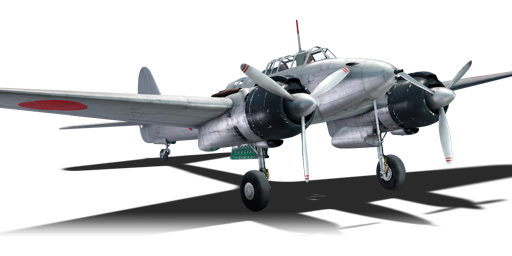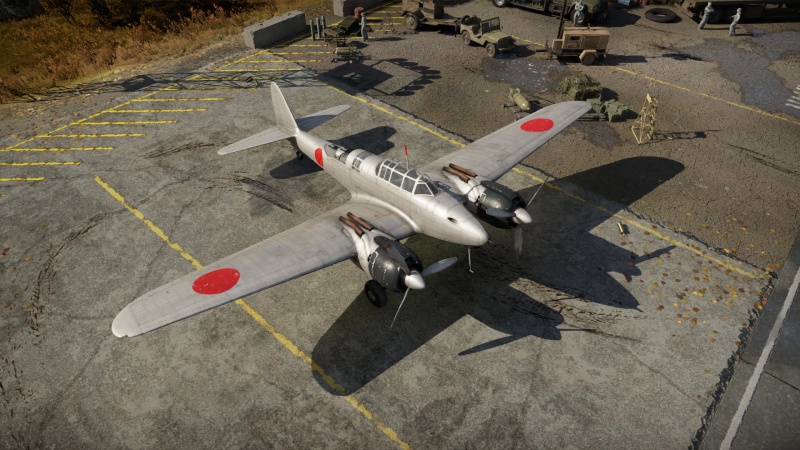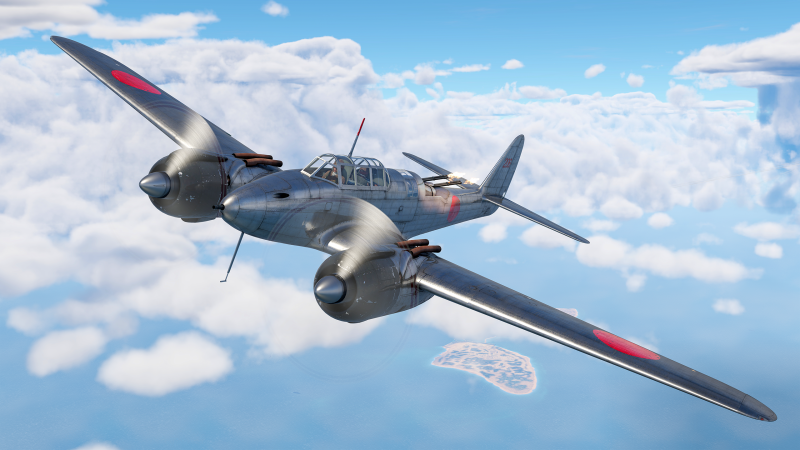Difference between revisions of "J1N1"
(→Description) |
m (→Description) |
||
| (One intermediate revision by one other user not shown) | |||
| Line 6: | Line 6: | ||
== Description == | == Description == | ||
<!-- ''In the description, the first part should be about the history of and the creation and combat usage of the aircraft, as well as its key features. In the second part, tell the reader about the aircraft in the game. Insert a screenshot of the vehicle, so that if the novice player does not remember the vehicle by name, he will immediately understand what kind of vehicle the article is talking about.'' --> | <!-- ''In the description, the first part should be about the history of and the creation and combat usage of the aircraft, as well as its key features. In the second part, tell the reader about the aircraft in the game. Insert a screenshot of the vehicle, so that if the novice player does not remember the vehicle by name, he will immediately understand what kind of vehicle the article is talking about.'' --> | ||
| − | The '''{{Specs|name}}''', a prototype in the J1N series, was initially designed in 1938 to | + | The '''{{Specs|name}}''', a prototype in the J1N series, was initially designed in 1938 to fulfill the Japanese Navy Air Service's need for an extended-range escort fighter for bombers. This was essential because navy fighter squadrons at the time lacked the necessary navigation and communication capabilities for lengthy land-based bomber sorties. However, due to slow development, testing could only be conducted in 1941, by which time the [[A6M]] had already proven itself as a very capable long-range fighter, capable of escorting bombers with its impressive range. The J1N1 struggled with its maneuverability, only barely meeting the speed and cruising range requirements, and the two dual remote turrets it was equipped with were prone to reliability issues. Despite these drawbacks, the J1N1 did impress the Navy with its range, leading to its redesignation as the '''Type 2 Land Reconnaissance Plane (J1N1-C / later J1N1-R)''', intended to replace older land-based reconnaissance aircraft. Later variants of the J1N were up-armed with obliquely mounted 20 mm cannons specifically for shooting down bombers. This led to the development of the night-fighter variant, which entered service as the '''{{Annotation|Gekkō|月光 - 'Moonlight'}} (J1N1-S)*'''. The J1N also served as the template for the [[J5N1|J5N ''{{Annotation|Tenrai|天雷 - 'Heavenly Thunder'}}'']]. |
| − | This aircraft was introduced in [[Update 1.63 "Desert Hunters"]]. The J1N1 prototype | + | This aircraft was introduced in [[Update 1.63 "Desert Hunters"]]. The J1N1 prototype offers a unique experience as a long-range twin-engine escort fighter with some uncommon features and later-year equipment for its relatively low tier and BR. To address the naturally limited manoeuvrability of a twin-engine aircraft, it is equipped with wing edge-leading slats and automatic flaps, which help maximize its agility. The aircraft's defensive armament includes four 7.7 mm guns mounted in two dual remote turrets with favourable angles, along with a [[Type 99 Model 2 (20 mm)]] cannon, a rare feature at this tier until later A6M5 models. The J1N1 should initially be used to hunt bombers to maximise its damage output. You can engage these targets with the forward armament or by positioning the aircraft in front and beneath the enemy bomber to utilize the gunner's firepower. After securing altitude advantage, the aircraft can transition to a Boom-and-Zoom strategy, diving on lower altitude targets with the remaining ammo in the forward armament. |
| + | |||
| + | ;Nicknames: | ||
| + | * [[Abbreviations#.28IJN.29_Official_name_designation|Official Designation]] '''(J1N1-S)'''*: ''月光 (Gekkō, "Moonlight")'' | ||
| + | * Allied reporting name: Irving | ||
== General info == | == General info == | ||
| Line 190: | Line 194: | ||
{{AirManufacturer Nakajima}} | {{AirManufacturer Nakajima}} | ||
| − | {{Japan twin-engine fighters}} | + | {{Japan twin-engine fighters and attackers}} |
Latest revision as of 00:50, 31 August 2024
Contents
Description
The J1N1, a prototype in the J1N series, was initially designed in 1938 to fulfill the Japanese Navy Air Service's need for an extended-range escort fighter for bombers. This was essential because navy fighter squadrons at the time lacked the necessary navigation and communication capabilities for lengthy land-based bomber sorties. However, due to slow development, testing could only be conducted in 1941, by which time the A6M had already proven itself as a very capable long-range fighter, capable of escorting bombers with its impressive range. The J1N1 struggled with its maneuverability, only barely meeting the speed and cruising range requirements, and the two dual remote turrets it was equipped with were prone to reliability issues. Despite these drawbacks, the J1N1 did impress the Navy with its range, leading to its redesignation as the Type 2 Land Reconnaissance Plane (J1N1-C / later J1N1-R), intended to replace older land-based reconnaissance aircraft. Later variants of the J1N were up-armed with obliquely mounted 20 mm cannons specifically for shooting down bombers. This led to the development of the night-fighter variant, which entered service as the Gekkō (J1N1-S)*. The J1N also served as the template for the J5N Tenrai.
This aircraft was introduced in Update 1.63 "Desert Hunters". The J1N1 prototype offers a unique experience as a long-range twin-engine escort fighter with some uncommon features and later-year equipment for its relatively low tier and BR. To address the naturally limited manoeuvrability of a twin-engine aircraft, it is equipped with wing edge-leading slats and automatic flaps, which help maximize its agility. The aircraft's defensive armament includes four 7.7 mm guns mounted in two dual remote turrets with favourable angles, along with a Type 99 Model 2 (20 mm) cannon, a rare feature at this tier until later A6M5 models. The J1N1 should initially be used to hunt bombers to maximise its damage output. You can engage these targets with the forward armament or by positioning the aircraft in front and beneath the enemy bomber to utilize the gunner's firepower. After securing altitude advantage, the aircraft can transition to a Boom-and-Zoom strategy, diving on lower altitude targets with the remaining ammo in the forward armament.
- Nicknames
- Official Designation (J1N1-S)*: 月光 (Gekkō, "Moonlight")
- Allied reporting name: Irving
General info
Flight performance
| Characteristics | Max Speed (km/h at 5,000 m) |
Max altitude (metres) |
Turn time (seconds) |
Rate of climb (metres/second) |
Take-off run (metres) | |||
|---|---|---|---|---|---|---|---|---|
| AB | RB | AB | RB | AB | RB | |||
| Stock | 502 | 487 | 10000 | 26.0 | 26.7 | 6.8 | 6.8 | 500 |
| Upgraded | 543 | 522 | 24.1 | 25.0 | 13.0 | 9.6 | ||
Details
| Features | ||||
|---|---|---|---|---|
| Combat flaps | Take-off flaps | Landing flaps | Air brakes | Arrestor gear |
| ✓ | ✓ | ✓ | X | X |
| Limits | ||||||
|---|---|---|---|---|---|---|
| Wings (km/h) | Gear (km/h) | Flaps (km/h) | Max Static G | |||
| Combat | Take-off | Landing | + | - | ||
| 712.5 | 350 | 432 | 409 | 290 | ~9 | ~6 |
| Optimal velocities (km/h) | |||
|---|---|---|---|
| Ailerons | Rudder | Elevators | Radiator |
| < 360 | < 320 | < 450 | > 335 |
Survivability and armour
- 8.5 mm Steel plate behind the Pilot.
Modifications and economy
Armaments
Offensive armament
The J1N1 is armed with:
- 1 x 20 mm Type 99 Model 2 cannon, nose-mounted (60 rpg)
- 2 х 7.7 mm Type 97 machine gun, nose-mounted (600 rpg = 1200 total)
Suspended armament
The J1N1 can be outfitted with the following ordnance:
- Without load
- 2 x 60 kg Navy Type 97 Number 6 bombs (120 kg total)
Defensive armament
The J1N1 is defended by:
- 4 x 7.7 mm Type 97 machine gun (750 rpg = 3,000 total)
Usage in battles
Unlike most Japanese aircraft, the J1N1 can take quite a lot of punishment. As a twin-engine fighter/interceptor/attacker, it has the ability to remain in operation even flying on only one engine and with partial wing missing. While there is no real protection for its fuel tanks, it is less likely to catch fire when compared to other Japanese aircraft at its battle rating. If playing Realistic Battles, it is battle rating is slightly higher than arcade, but its forte is really in arcade battles at its battle rating. Its bomb load is relegated to smaller bomb sizes, but at the battle rating, it is enough to take out a few ground targets. The autocannons and machine guns on the aircraft are sufficient to perform strafing runs on lightly armoured vehicles.
The J1N1 flying low in AB can be a real distraction for the enemy team, keeping them away from the objectives of destroying ground targets. None of its weapons cannons is very powerful and its ammo count is quite low, but in arcade battles that is not much of a problem with in-flight reloadable ammunition when you run out. For quite a large aircraft, it is very manoeuvrable, and the "ace up its sleeve" is the rear-facing turrets, each with two 7.7 mm machine guns and unlike other fighters and bombers at its battle rating, the rear gunners are enclosed within the aircraft and not exposed to stray bullets. Enemy fighters on the tail of a J1N1 often find they suffer critical damage or are shot down while the offensive guns are trained on oncoming aircraft or ground targets. The playstyle is neither "Boom & Zoom" nor "Turn & Burn", but rather to fly low and drag the enemy onto the tail of the J1N1. In arcade battle, enemies will sometimes try to ram the J1N1, in an attempt to knock off a wing, but it will continue to fly, often losing only the wingtip.
This aircraft is less useful in realistic and simulator battles mainly due to its low ammo count, but the characteristic play style mentioned before could prove almost as rewarding and it can take quite a bit of punishment before being destroyed.
Manual Engine Control
| MEC elements | ||||||
|---|---|---|---|---|---|---|
| Mixer | Pitch | Radiator | Supercharger | Turbocharger | ||
| Oil | Water | Type | ||||
| Controllable | Controllable Not auto controlled |
Controllable Auto control available |
Controllable Auto control available |
Separate | Controllable 2 gears |
Not controllable |
Pros and cons
Pros:
- Quadruple 7.7 mm defensive guns in a dangerous tight array
- Fairly good speed
- 8.5 mm of armour in pilot's seat
- Good manoeuvrability
- Two engine design for extra survivability
Cons:
- Beaten in turn fights by some aircraft
- Limited ammunition for all weapons
- Lack of protection around fuel tanks, engines, and gunner
- A single gunner man all four guns. When hit, all four weapons stop working
- Slightly-lacking climb rate for up-tiers.
- Offensive 7.7 mm struggle to down aircraft effectively
History
The Nakajima J1N1 Gekko (Moonlight), nicknamed the "Irving" by allied pilots was a 3 crew twin-engine fighter.
First developed the replace the A5M series as escorts for the Japanese bombers of the day (G3M). The main requirement for the aircraft was manoeuvrability and distance. It met the requirements on paper; however, due to the addition of rear-facing guns, the performance of the aircraft was hindered, as such the J1N's role of an escort fighter was scrapped.
Equipped with two "Nakajima NK1F Sakae 21" 14cylinder radial engine's producing 1,130 horsepower each. It had a maximum range of 3,780 km (2,350 mi) if stripped of all weapons. This made it ideal for reconnaissance and was used for recon. During the beginning of the war with the Allies, the J1N was perfect for its reconnaissance role; however, when the war started favouring night attacks, the J1N was no longer equipped to serve its role.
Japanese Commander Yasuna Kozono noticed the plane could not serve as a nighttime recon, he equipped two upwards firing 20 mm Type 99 cannons. Upon the new variants first sortie it downed two American bombers by flying under them and firing on the unsuspecting bomber crew. This success was immediately noticed by the Japanese Military and ordered Nakajima (the developers of the plane) to produce night fighting variants.
At first, the J1N night fighters were equipped with a spotlight on the nose, but when the Japanese developed a radar it saw extreme success. The American Military did not think the Japanese were capable of building a night fighter, leading to the destruction of many B-17's.
The J1N would have many variants designed for intercepting bombers and would be seen throughout the war. With the Allies use of the B-29 at the end of the war, the J1N could no longer out the Ally bombers. The J1N's success slowly started to fade, but some extremely skilful pilots such as Sachio Endo were still capable of downing many B-29's despite their plane being vastly outdated in 1945.
479 J1Ns were built, with only 1 surviving the war. The surviving aircraft can be found at the Steven F. Udvar-Hazy Center in Chantilly, in Virginia USA.
Media
- Skins
See also
Links to the articles on the War Thunder Wiki that you think will be useful for the reader, for example:
- reference to the series of the aircraft;
- links to approximate analogues of other nations and research trees.
External links
| Nakajima Aircraft Company (中島飛行機株式会社 ) | |
|---|---|
| Fighters | Ki-27 otsu · Ki-27 otsu Tachiarai |
| Ki-43-I · Ki-43-II · Ki-43-III otsu | |
| Ki-44-I · Ki-44-I 34 · Ki-44-II otsu · Ki-44-II hei | |
| Ki-84 ko · Ki-84 otsu · Ki-84 hei | |
| Ki-87 | |
| Hydroplanes | A6M2-N* |
| Interceptors | J1N1 · J5N1 |
| Bombers | B5N2 |
| B6N1 Model 11 · B6N2 Model 12 · B6N2a Model 12Ko | |
| G5N1 · G8N1 | |
| Ki-49-I · Ki-49-IIa · Ki-49-IIb · Ki-49-IIb/L | |
| Recon | E8N2 |
| Jet Fighters | Kikka |
| Captured | ␗Ki-27 otsu · ▃Ki-43-II · ␗Ki-43-III ko · ␗Ki-44-II hei · ␗Ki-84 ko |
| *Refit of the Mitsubishi A6M2 mod. 11 | |
| See also | Fuji Heavy Industries (1957-2017) |
| Japan twin-engine fighters and strike aircraft | |
|---|---|
| Navy | |
| Land-based Fighter | |
| J1N | J1N1 |
| J5N | J5N1 |
| Army | |
| Ki-45 | Ki-45 ko · Ki-45 otsu · Ki-45 hei · Ki-45 tei |
| Ki-83 | Ki-83 |
| Ki-96 | Ki-96 |
| Ki-102 | Ki-102 otsu |
| Ki-108 | Ki-108 Kai |
| Ki-109 | Ki-109 |






